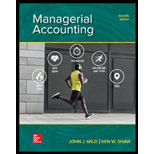
Profit margin ratio:
Profit margin ratio shows proportion of net income in terms of sales. Earning capability is measured by this ratio.
Gross profit ratio:
Gross profit ratio is the ratio of gross margin expressed in form of percentage of sales. This ratio shows the profit earned by the company after paying off cost of sold goods.
Return on total assets ratio:
Company’s earnings made through its net assets is known as return on total assets ratio.
Return on common
Return on common stockholder’s equity displays returns received on stockholder’s equity for a certain period of time.
Earnings per share:
Earnings per share show the profit allocated to per share of common stock of the company.
To compute: 1.Profit margin ratio 2.Gross profit ratio 3.Return on total assets 4. Return on common stockholder’s equity 5.Basic net income per common share of H Company.
Want to see the full answer?
Check out a sample textbook solution
Chapter 13 Solutions
Managerial Accounting (Looseleaf)
- I am looking for the most effective method for solving this financial accounting problem.arrow_forwardA company reported the following information for its most recent year of operation: purchases, $175,000; beginning inventory, $35,000; and cost of goods sold, $180,000. How much was the company's ending inventory?need helparrow_forwardI need help with this problem and accountingarrow_forward
- At the beginning of the year, Vertex Technologies, Inc. determined that estimated overhead costs would be $540,000, while actual overhead costs for the year totaled $562,000. Furthermore, it was determined that the estimated allocation basis would be 60,000 machine hours, while production actually required 63,500 machine hours. What was the dollar amount of underallocated or overallocated manufacturing overhead?arrow_forwardArmani Manufacturing produces widgets at a variable cost of $12 per unit. Fixed costs are $180,000 per year. If each widget sells for $27, how many units must be sold to break even?arrow_forwardWhat characterizes the aggregate constraint principle in accounting? (a) Economic constraints don't affect reporting (b) Only individual transactions matter (c) Resources available limit total possible economic activity reporting (d) Business size determines all limitationsarrow_forward
- Icarus Tools produces 4,100 units. Each unit was expected to require 2.2 labor hours at a cost of $12 per hour. Total labor cost was $107,100 for 9,000 hours worked. Direct labor is measured in labor hours. What is the flexible budget variance for direct labor?arrow_forwardThe actual cost of direct labor per hour is $29.75 and the standard cost of direct labor per hour is $31.20. The direct labor hours allowed per finished unit is 0.85hours. During the current period, 7,500 units of finished goods were produced using 4,100 direct labor hours. How much is the direct labor rate variance?arrow_forwardI need guidance with this general accounting problem using the right accounting principles.arrow_forward

 AccountingAccountingISBN:9781337272094Author:WARREN, Carl S., Reeve, James M., Duchac, Jonathan E.Publisher:Cengage Learning,
AccountingAccountingISBN:9781337272094Author:WARREN, Carl S., Reeve, James M., Duchac, Jonathan E.Publisher:Cengage Learning, Accounting Information SystemsAccountingISBN:9781337619202Author:Hall, James A.Publisher:Cengage Learning,
Accounting Information SystemsAccountingISBN:9781337619202Author:Hall, James A.Publisher:Cengage Learning, Horngren's Cost Accounting: A Managerial Emphasis...AccountingISBN:9780134475585Author:Srikant M. Datar, Madhav V. RajanPublisher:PEARSON
Horngren's Cost Accounting: A Managerial Emphasis...AccountingISBN:9780134475585Author:Srikant M. Datar, Madhav V. RajanPublisher:PEARSON Intermediate AccountingAccountingISBN:9781259722660Author:J. David Spiceland, Mark W. Nelson, Wayne M ThomasPublisher:McGraw-Hill Education
Intermediate AccountingAccountingISBN:9781259722660Author:J. David Spiceland, Mark W. Nelson, Wayne M ThomasPublisher:McGraw-Hill Education Financial and Managerial AccountingAccountingISBN:9781259726705Author:John J Wild, Ken W. Shaw, Barbara Chiappetta Fundamental Accounting PrinciplesPublisher:McGraw-Hill Education
Financial and Managerial AccountingAccountingISBN:9781259726705Author:John J Wild, Ken W. Shaw, Barbara Chiappetta Fundamental Accounting PrinciplesPublisher:McGraw-Hill Education





